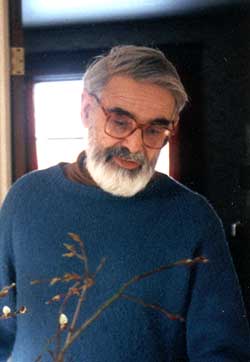 Hans Peter Kahn was born in Leipzig, Germany, in 1921, to Emil Kahn, a composer and conductor, and to Nellie Budge Kahn, poet and harpist. In Germany Kahn attended the original Waldorf School and The Stuttgart Gymnasium. When conditions became untenable, Kahn left Germany in 1937 at the age of sixteen for New York City, rejoining his father. He worked as a window designer at Bamberger’s, attending Pratt Institute in Brooklyn under a scholarship. He later worked as a union organizer and commercial graphics designer. In 1942, he joined the US Army.
Hans Peter Kahn was born in Leipzig, Germany, in 1921, to Emil Kahn, a composer and conductor, and to Nellie Budge Kahn, poet and harpist. In Germany Kahn attended the original Waldorf School and The Stuttgart Gymnasium. When conditions became untenable, Kahn left Germany in 1937 at the age of sixteen for New York City, rejoining his father. He worked as a window designer at Bamberger’s, attending Pratt Institute in Brooklyn under a scholarship. He later worked as a union organizer and commercial graphics designer. In 1942, he joined the US Army.
After active duty in Europe, Kahn served as an interpreter in the early stages of the Nuremberg Trials and returned to New York in 1945. He then studied at the Art Students League with Vaslov Vytlacil. He also took advantage of a scholarship to the Hans Hofmann School given him by the painter/teacher. In 1947 he met and married children’s book writer Ruth Stiles Gannett. When Hofmann’s School became eligible for the GI Bill, Kahn and other returning soldier/artists enrolled with the master teacher. Kahn was his assistant in Hofmann’s Provincetown school in 1949. In addition, Kahn received an undergraduate degree in art in 1950 and a Master’s degree in Philosophy in 1952 from New York University.
Kahn taught art during the summer program at Sarah Lawrence College in 1949 and, from 1952-54, at Louisiana State University in Baton Rouge. He accepted the Chairmanship of the Art Department at Hampton Institute (now Hampton University) in Hampton, Virginia.
 In 1957, Kahn accepted a tenure-track position in the Fine Arts Department at Cornell University and moved with his wife and five daughters to a farm in Etna, New York. He taught painting, graphic arts, and calligraphy, producing two books on calligraphy as a teaching tool. He also produced theater sets for campus productions and, by various graphic techniques, numerous political posters and announcements of Cornell concerts and lectures. Kahn entered a a period of prolific production in his large Etna studio, including the birth of two more daughters. Over the years, the Kahn’s farmhouse and gardens became the Sunday destination for a number of subsequently well-known Cornell students, including Richard Farina, Gordon Matta, Thomas Pynchon and C. Michael Curtis.
In 1957, Kahn accepted a tenure-track position in the Fine Arts Department at Cornell University and moved with his wife and five daughters to a farm in Etna, New York. He taught painting, graphic arts, and calligraphy, producing two books on calligraphy as a teaching tool. He also produced theater sets for campus productions and, by various graphic techniques, numerous political posters and announcements of Cornell concerts and lectures. Kahn entered a a period of prolific production in his large Etna studio, including the birth of two more daughters. Over the years, the Kahn’s farmhouse and gardens became the Sunday destination for a number of subsequently well-known Cornell students, including Richard Farina, Gordon Matta, Thomas Pynchon and C. Michael Curtis.
In addition to his regular schedule, Kahn served as Chair of the Advanced Placement in Art Program with the Educational Testing Service (1970-74) and as a visiting artist and teacher at the University of Virginia, the London Royal College of Art, Cal Tech, New York University and Hobart College.
In 1968, in part in response to the Vietnam War, Kahn moved his family to the University of Victoria in Victoria, British Columbia, Canada, where he taught book arts, painting and art history. In 1970, Kahn returned to Cornell University in the History of Art Department. There he taught art history courses such as “The History of the Book”and “The History of the Technique of Making Art”as well as numerous cross-disciplinary courses with colleagues in philosophy, music and literature.
Following his formal retirement in 1984, Kahn was much in demand for Cornell’s summer alumni program, teaching summer courses and leading several art history tours: one to London and Paris, another to Holland and Belgium. He and his wife Ruth also spent 1985-86 in Hamburg, Germany setting up the Cornell Abroad Program at Hamburg University. At his barn studio and print shop in Trumansburg, New York, Kahn continued to teach painting techniques, typography, calligraphy and print making. He also continued to paint, to make woodcuts and book illustrations as well as posters and theater sets. He was a committed member of the Trumansburg Volunteer Fire Department for twenty years until his death on duty in 1997.